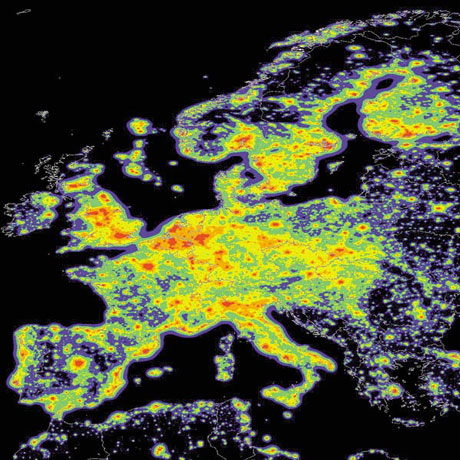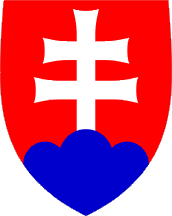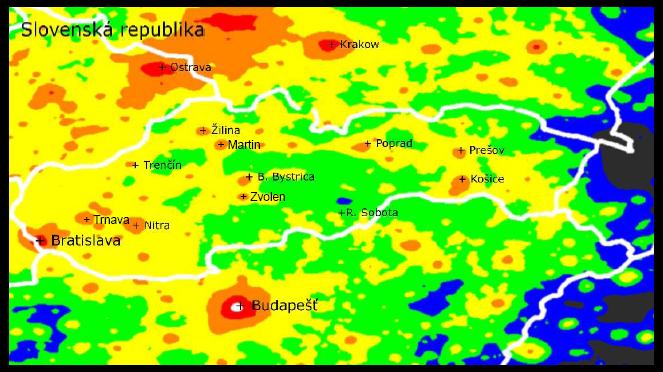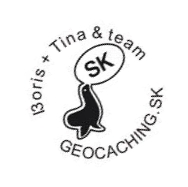 This earthcache will reveal one of the few places in Slovakia where you can see the stars and actually night, as they saw it for generations of our ancestors. At one moment you can see up to 3500 stars at once. In contrast, in an urban agglomeration, you can see 20 to 50 stars. This Place is located in front of the gate to the "Dark sky Poloniny Park, which lies in the northeastern part of Slovakia, on the border with Poland and Ukraine. In this territory (Poloniny National Park) is minimal population of people, also the highest concentration of untouched forests in Slovakia. Poloniny name is derived from mountain meadows -
This earthcache will reveal one of the few places in Slovakia where you can see the stars and actually night, as they saw it for generations of our ancestors. At one moment you can see up to 3500 stars at once. In contrast, in an urban agglomeration, you can see 20 to 50 stars. This Place is located in front of the gate to the "Dark sky Poloniny Park, which lies in the northeastern part of Slovakia, on the border with Poland and Ukraine. In this territory (Poloniny National Park) is minimal population of people, also the highest concentration of untouched forests in Slovakia. Poloniny name is derived from mountain meadows - Poloniny, which are located on the crest Bukovské hills.
Poloniny, which are located on the crest Bukovské hills. The Poloniny National Park is situated in the north-eastern part of Slovakia and it borders with Poland and the Ukraine. The Protected Landscape Area of
Eastern Carpathians lies in the north-eastern part of the Snina region. In 1993 it was designated by UNESCO as the International Biospheric reservation of
Eastern Carpathians. Its area is 164190 ha. It is the only reservation in the world created by an area of three countries. Since 1.10.1997 part of the biospheric reservation in the Snina region was designated the Poloniny National Park. Mountain meadows - pastures - are typical for this national park. They can be found on mountain ranges in the Bukovské hills/Bukovské vrchy. The most beautiful are near Plaša, Durkovec, Riaba rock/skala and Kamenná lúka/Kamenná meadow.
Geology:
Territory of National park Poloniny is built mostly on sandstone. Base is largely made of sandstone and clay.
Minimal population of people and especially the local landscape in this area helps block light pollution. Surrounding mountains form a barrier to artificial light from nearby cities - Eastern Carpathians in the West, the South Vihorlat and Bukovske mountains in the north.
Light pollution (interference light or light milk) is not a problem only for astronomers and lovers of the night sky. The problem extends into many areas of life, often without us realizing it. The victims of light pollution are different kinds of plants and animals. It has negative impact on man and his health too. We are loosing what we had for millions of years - starry sky overhead.
Poloniny is the only Slovak National Park which prove you on clear nights to show the most beautiful starry sky. Such places seeking by astronomers and photographers from around the world for observing and photographing the starry sky of the earth's surface. Under ideal weather conditions it is possible to observe the stars and space objects from the night sky which has disappeared in the vicinity of cities."Thanks to" light pollution is a dark sky Poloniny Park one of the few places in Slovakia, where you can actually see the real darkness.
Light pollution is generally light with adverse effects. Its source is in particular public lighting. Due to improper and unnecessarily intense lighting. Light scattered in the atmosphere creates a "light smog". To illustrate this the light pollution scale was developed, expressed in degrees and colours of rainbow. Blue and green are natural places close to where the night’s environment is relatively unaffected. In the orange and red areas the sky brightness is so strong that it is not possible to see the Milky Way.
- What is the degree of the night sky brightness in the National Park Poloniny? (number)
- How is called the upper layer of sediments of the National Park, consisting of sandstone and clay?
- Through how many countries in Europe is located Carpathian mountain massif and how to call its highest point?
- How many stars can you see in the night sky at one moment?
- List at least one method which can prevent light pollution.
- OPTIONAL: You can attach your photo in the information board, which waypoint is pointing to.
- OPTIONAL - BONUS: If you can make a nice photo of the night sky (in the territory of national park Poloniny), attach it to logs and you do not have to answer the questions above.
Logs "Found it" without sending a reply will be deleted.

 Tato earthcache vam chce ukazat jedno z poslednych miest na Slovensku kdem môzete vidiet hviezdnu oblohu a skutocnu noc tak, ako ju videli cele generacie nasich predkov. V jednom momente tu mozete vidiet na nocnej oblohe az 3500 hviez naraz. Naproti tomu v mestskej aglomeracii, mozete vidiet vidiet 20 az 50 hviez. Uvodne suradnice vas privedu pred branu "Parku tmavej oblohy Poloniny", ktory lezi v severovychodnej casti Slovenska, na hraniciach s Polskom a Ukrajinou. Na tomto uzemi (Narodny park Poloniny) je najnizsia hustota osidlenia na Slovensku a zaroven najvyssia koncentracia nedotknutych lesov (pralesov) na uzemi Slovenska. Nazov Poloniny je odvodeny od horskych luk - polonin, ktore sa nachadzaju na hrebenoch Bukovskych vrchov. Súcastou tejto severovýchodnej casti regiónu je Chránená krajinná oblast Východné Karpaty. Táto cast chráneného územia bola v roku 1993 svetovou organizáciou UNESCO vyhlásená za Medzinárodnú biosférickú rezerváciu Východné Karpaty. Jej výmera je 164 190 ha. Je to jediná rezervácia na svete, ktorú tvoria spojené územia troch štátov. Od 1.10.1997 bola cast biosférickej rezervácie v okrese Snina vyhlásená za Národný park Poloniny.
Tato earthcache vam chce ukazat jedno z poslednych miest na Slovensku kdem môzete vidiet hviezdnu oblohu a skutocnu noc tak, ako ju videli cele generacie nasich predkov. V jednom momente tu mozete vidiet na nocnej oblohe az 3500 hviez naraz. Naproti tomu v mestskej aglomeracii, mozete vidiet vidiet 20 az 50 hviez. Uvodne suradnice vas privedu pred branu "Parku tmavej oblohy Poloniny", ktory lezi v severovychodnej casti Slovenska, na hraniciach s Polskom a Ukrajinou. Na tomto uzemi (Narodny park Poloniny) je najnizsia hustota osidlenia na Slovensku a zaroven najvyssia koncentracia nedotknutych lesov (pralesov) na uzemi Slovenska. Nazov Poloniny je odvodeny od horskych luk - polonin, ktore sa nachadzaju na hrebenoch Bukovskych vrchov. Súcastou tejto severovýchodnej casti regiónu je Chránená krajinná oblast Východné Karpaty. Táto cast chráneného územia bola v roku 1993 svetovou organizáciou UNESCO vyhlásená za Medzinárodnú biosférickú rezerváciu Východné Karpaty. Jej výmera je 164 190 ha. Je to jediná rezervácia na svete, ktorú tvoria spojené územia troch štátov. Od 1.10.1997 bola cast biosférickej rezervácie v okrese Snina vyhlásená za Národný park Poloniny.
Geologia:
Uzemie narodneho parku ma prevazne pieskovcovy charakter. Odolne pieskovcove vrstvy tvoria horske chrbty, v menej odolnych ilovcovych vrstvach vznikli depresie ako napr. Ruska kotlina, Runinska kotlina, Ulicska kotlina a Sedlicka kotlina.
Mimoriadne nizka hustota osidlenia a specialne miestne podmienky chrania toto uzemie pred svetelnym znecistenim z väcsich miest. Okolite pohoria tvoria barieru pre taketo neziaduce nocne svetlo. Zo severu su to Bukovske vrchy, zo zapadu Východne Karpaty a na juhu Vihorlat. Vsetky tieto pohoria patria do Karpatského horskeho masivu, ktory je najväcsim v Europe.
Svetelne znecistenie (rusive svetlo) nie je problemom vyhradne astronomov a milovnikov nocnej oblohy. Problem zasahuje do mnohych oblasti zivota, velakrat bez toho, aby sme si to uvedomovali. Obetami svetelneho smogu su rozne druhy rastlin a zivocichov. Negativny vplyv ma aj na cloveka a jeho zdravie. Nevraviac o tom, ze stracame to co sme tu mali miliony rokov - hviezdne nebo nad hlavou.
Poloniny su jediny slovensky narodny park, ktory vam dokaze pocas jasnych noci ukazat najkrajsiu hviezdnu oblohu, aka sa da na Slovensku vidiet. Taketo miesta vyhladavaju astronomovia a fotografi z celeho sveta pre pozorovanie a fotografovanie hviezdnej oblohy zo zemskeho povrchu. Za idealnych poveternostnych podmienok je mozne pozorovat hviezdy a vesmirne objekty, ktore sa z nocnej oblohy v okoli miest uz davno vytratili. "Vdaka" svetelnemu znecisteniu je Park tmavej oblohy Poloniny jednym z poslednych miest na Slovensku, kde mozete videt skutocnu tmu.
Svetelne znecistenie je vo vseobecnosti svetlo s neziaducimi ucinkami. Jeho zdrojom je predovsetkym verejne osvetlenie. Vznika nespravnym a zbytocne intenzivnym osvetlovanim. Svetlo rozptylene v atmosfere vytvara svetelny smog. Pre nazornost bola vypracovana stupnica svetelneho znecistenia vyjadrena vo farbach duhy a ciselnych stupnoch. Modra a zelena su miesta blizke prirodnym, kde je nocne prostrednie relativne nedotknuté. V oranzovych a cervenych oblastiach je presvetlenie oblohy take silne, ze nie je vidiet ani Mliecnu drahu.


Táto keška bola nominovaná na Slovak GeoAwards 2014
Pre zalogovanie tejto cache mi poslite odpovede na tieto otazky:
- Aky je stupen jasu nocnej oblohy na uzemi narodneho parku Poloniny? (cislo)
- Kolko hviezd tu je mozete naraz vidiet na nocnej oblohe?
- Ako sa nazyva vonkajsia vrstva sedimentov uzemia narodneho parku, tvorena z pieskovca a ilu?
- Cez kolko europskych krajin prechadza Karpatsky horsky masiv a ako sa vola jeho najvyssi bod?
- Uvedte aspon jeden sposob ktorym sa da predchadzat svetelnemu znecisteniu.
- NEPOVINNE: Mozete prilozit vase foto pri infotabuli, na ktoru ukazuje waypoint
- NEPOVINNE - BONUS: - ak dokazete urobit pekne foto nocnej oblohy (na uzemi narodneho parku Poloniny), prilozte ju k logu a nemusite odpovedat na predosle otazky.
Logy "Found it" bez zaslania odpovedi cez formulár budu zmazane.
"Zhasnete lampiony, ja chci videt tmu!"
Yvetta Simonová